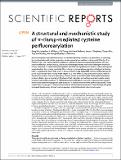A structural and mechanistic study of π-clamp-mediated cysteine perfluoroarylation
Author(s)
Dai, Peng; Williams, Jonathan Kyle; Zhang, Chi; Welborn, Matthew Gregory; Shepherd, James J; Zhu, Tianyu; Van Voorhis, Troy; Hong, Mei; Pentelute, Bradley L.; ... Show more Show less
DownloadDai_et_al-2017-Scientific_Reports.pdf (3.010Mb)
PUBLISHER_CC
Publisher with Creative Commons License
Creative Commons Attribution
Terms of use
Metadata
Show full item recordAbstract
Natural enzymes use local environments to tune the reactivity of amino acid side chains. In searching for small peptides with similar properties, we discovered a four-residue π-clamp motif (Phe-Cys-Pro-Phe) for regio- and chemoselective arylation of cysteine in ribosomally produced proteins. Here we report mutational, computational, and structural findings directed toward elucidating the molecular factors that drive π-clamp-mediated arylation. We show the significance of a trans conformation prolyl amide bond for the π-clamp reactivity. The π-clamp cysteine arylation reaction enthalpy of activation (ΔH‡) is significantly lower than a non-π-clamp cysteine. Solid-state NMR chemical shifts indicate the prolyl amide bond in the π-clamp motif adopts a 1:1 ratio of the cis and trans conformation, while in the reaction product Pro3 was exclusively in trans. In two structural models of the perfluoroarylated product, distinct interactions at 4.7 Å between Phe1 side chain and perfluoroaryl electrophile moiety are observed. Further, solution 19F NMR and isothermal titration calorimetry measurements suggest interactions between hydrophobic side chains in a π-clamp mutant and the perfluoroaryl probe. These studies led us to design a π-clamp mutant with an 85-fold rate enhancement. These findings will guide us toward the discovery of small reactive peptides to facilitate abiotic chemistry in water.
Date issued
2017-08Department
Massachusetts Institute of Technology. Department of ChemistryJournal
Scientific Reports
Publisher
Nature Publishing Group
Citation
Dai, Peng, et al. “A Structural and Mechanistic Study of π-Clamp-Mediated Cysteine Perfluoroarylation.” Scientific Reports 7, 1 (August 2017): 7954 © 2017 The Author(s)
ISSN
2045-2322